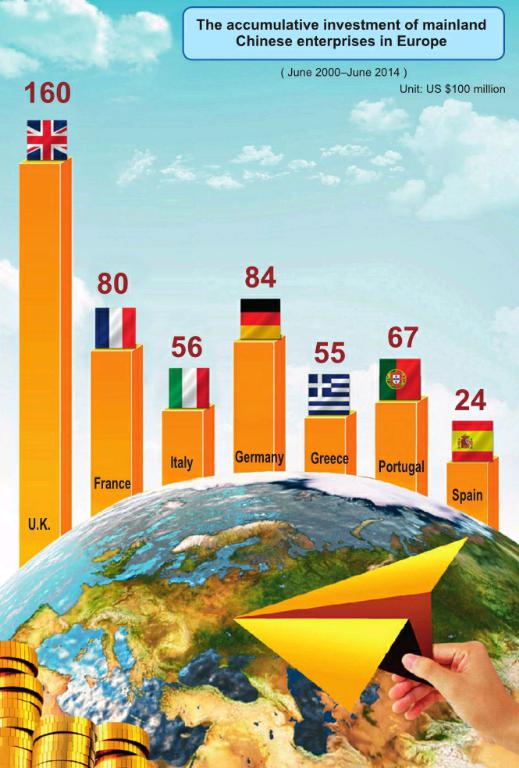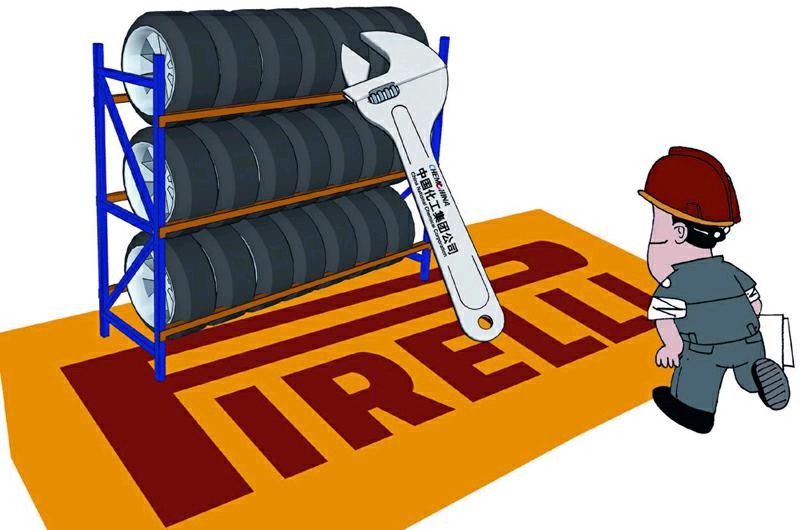A Win-Win Choice
By+staff+reporter+HOU+RUILI
ACCORDING to a report in the Financial Times, European countries and enterprises that are teetering on the edge of a debt crisis are looking to China for investment.
While the European debt crisis has eroded the value of the euro, falling asset prices have attracted the interest of foreign companies, including Chinese enterprises. Europe is in urgent need of foreign investment to remedy the economic downturn, and China is willing to lend a hand.
Mushrooming Investments
In 2005, Chinese enterprises investment in Europe totaled US $190 million. Fast-forward to 2014 and this figure rose to US $9.8 billion, a 50-fold increase within a decade. In the past four years, China has directly invested US $10 billion in Europe annually.
According to a report released by the multinational law firm Baker & McKenzie last February, Chinas foreign direct investment (FDI) in Europe set a record US $18 billion in 2014, almost double that of 2013. In 2014, the U.K. was Chinas first FDI destination, and reached US $5.1 billion. Italy was in second place, with the latest investment reaching US $3.5 billion. Since 2000, the U.K. has retained the top spot of Chinas FDI in Europe, amounting to about US $16 billion in total. The amount in Germany, France, Portugal, and Italy are respectively US $8.4 billion, US $8 billion, US$6.7 billion, and US $5.6 billion. Last year, Chinese investors showed particular interest in the U.K.s real estate market, splashing out US $2.3 billion in total in this area.
Since May 2014, the euro has depreciated by over 25 percent against the RMB. Undervalued European assets have sparked the investment interest of Chinese enterprises hoping to link domestic commodities and the market with Europe.
The pressure of sovereign debt crises and government financial deficits has forced European countries to further open up to foreign acquisitions, creating opportunities for Chinese companies.
Chinas economic transformation and upgrading have given wings to competent enterprises seeking to exploit brand and technology advantages via European investment, which in turn, promotes their commercial upgrading, too.
Food and Agriculture
Capitalizing on the new trend in China for Western produce and Mediterranean flavors, the Bright Food Group acquired 90 percent stock rights of Italian olive oil maker Salov Group in December 2014, thereby springboarding into the olive oil industry, which is flourishing in China.endprint
As early as June 2012, Bright Food bought a 70 percent stake in Bordeaux wine exporter Diva to gain a foothold in the wine-making region. Five months later, the company acquired 60 percent of the shares from British cereal maker Weetabix Ltd.
Brights mergers and acquisitions(M&A) give priority to such industries as dairy products, sugar and sweetening agents, modern agriculture, and wine.
Beijing-based private equity firm Hony Capital announced in July 2014 that it would buy the restaurant chain Pizza Express for about £900 million, the largest acquisition in five years in the European restaurant sector. Founded in 1965, Pizza Express has 435 outlets in the U.K. and 70 internationally.
According to Zhao Linghuan (John Zhao), CEO of Hony, the acquisition represented an organic bond of an overseas mature brand and Chinas flourishing market demand thanks to the nations urbanization and consumption upgrading.
Several factors, such as declining arable land, environmental pollution, and scattered agricultural operation, have led to a shortage of food companies in China that integrate production, processing, distribution, and sales. This has pushed Chinese companies to purchase overseas counterparts in the agriculture and food industry with the aim of satisfying domestic consumers demands for food safety and better quality of life.
According to research by Baker & McKenzie, the food and agriculture industries have become the most attractive fields for outgoing Chinese investment, receiving a total of US $4.1 billion in 2014. The energy industry, which previously dominated the top spot, now takes second place, with a total investment of US $3.7 billion. Real estate comes in third at US $3 billion.
Win-Win Choice
Chinese enterprises are also investing more in research and development(R&D), machine manufacturing, and real estate, bringing substantial benefits to the formerly faltering companies they purchased.
China National Chemical Corporation (ChemChina) agreed on March 22, 2015 to buy 65 percent of shares in tire maker Pirelli in a €7.1 billion deal that will place one of the symbols of Italys manufacturing industry in Chinese hands. Pirelli will maintain its operation and technological base in Milan, and ChemChina will control the distribution network in China, as well as Pirellis marketing channel in the U.S. and Latin America, which will double the new companys sales volume.endprint
Moreover, by establishing local R&D centers, Chinese companies are also spending on product research thereby achieving technological innovation by investing in world-leading science and technology talents. Advanced technology not only brings economic benefits to both sides, but also promotes local employment.
Huawei has established close cooperation with local market leaders. For instance, in June 2014, Huawei launched a cooperation initiative with Germanys Deutsche Telekom AG, hitting upon a solution of accessing bandwidth that binds mobile and fixed networks. By installing a router at home, consumers can now bind mobile and fixed broadband, which can increase the Internet connection speed four to seven times. After being put into commercial use last October, it has expanded the market on both sides.
Since entering Europe in 2001, Huawei has been generous with its investment, establishing an integrated research and development organization comprising 850 staff. In the next five years, the number of research personnel is expected to double. Despite the countrys high operating costs, Swedens Stockholm and Goteborg were the chosen places for Huaweis wireless and terminal R&D centers, as they are hubs for science and technology talents. Huawei has R&D centers in Milan, Munich, and Paris too, and boards of directors and advisory committees in the U.K. and France, where it invites local senior managers to participate in the formulation and implementation of its development strategy. The company actively trains local talents. In cooperation with the Italian government it cultivated 500 ICT (Information and Communication Technology) talents in 2003 alone.
Huawei has completed its European localization drive. Its spending in Europe reached US $3.4 billion in 2013, a year-on-year growth of 11 percent. Of its 7,700 employees in the region, some 80 percent are local. In the next five years, Huawei expects to recruit another 5,500 local workers.
Other new investment trends have further strengthened Sino-European enterprise cooperation, creating more space for development and profit. In the past decade, 70 percent of Chinas investment in Europe went to countries that had made it safely through the financial crisis. However, Chinese investors have recently been targeting privatization of assets in countries with comparatively weak economic strength, such as Greek harbors, Portugals Banco Espírito Santo, and irredeemable fixed assets in Spain.endprint
According to Thomas Gilles, chairman of the EMEA-China Group of Baker& McKenzie, a growing number of Chinese private enterprises, individual investors, private equities, and investment banks have increased their investment in Europe. Their participation has injected vitality into international M&A.
According to ChinaVenture, in 2014, private enterprises took part in 185 out of 219 cross-border M&A, accounting for 84 percent of Chinas total that year.
Create Opportunities
Despite their yearning for Chinese investment, a few European countries also fear that China will buy too much. According to Wu Yikang, a professor at the European Studies Center of the Shanghai Academy of Social Sciences, Chinas investment in Europe has mutual ben- efits and win-win results. China will neither purchase Europe nor become any countrys “savior”; but it will provide the continent with a chance to recover.
In the wake of the European debt crisis, Europe changed its over-prudent attitude towards overseas investment and greatly expanded its openness. Generally speaking, governments and business circles welcome investment from China.
French Prime Minister Manuel Valls showed great interest in Chinas investment during his visit to China last January. Italys Prime Minister, Matteo Renzi, was present at the signing ceremonies of the acquisition deals by Shanghai Electric Power and State Grid Corporation of China.
The European Commission unveiled a€315 billion investment plan in November 2014, which entailed the creation of a new European Fund for Strategic Investments. This will revitalize Europes stagnant economy on the premise that it will not add government bonds, which already total a hefty amount.
The plan will use foreign capital to improve the local infrastructure of transportation, telecommunications, and digital sectors. It encourages Chinese enterprises, such as ZTE and the Bank of China to invest in digital infrastructure construction by establishing joint venture enterprises, and cooperation between public institutions and private companies.
In the 1990s Europe led the technosphere of GSM (global system for mobile communications). However, it lags behind the U.S., Japan, and South Korea in the field of 4G network. According to ChinaEU, it is necessary for China and the EU to cooperate to obtain a strategic position in the future 5G mobile market by mobilizing their technology and market resources.
According to a report by Fran?oise Nicolas, director of the Center for Asian Studies at the French Institute of International Relations, the indirect yield of Chinese investment should not be underestimated. It helps local enterprises to shake off non-performing loans and gain imperative funds. Chinese investors bring higher returns to local research input. Above all, they give European companies the leg-up that they need to enter the Chinese market.endprint

